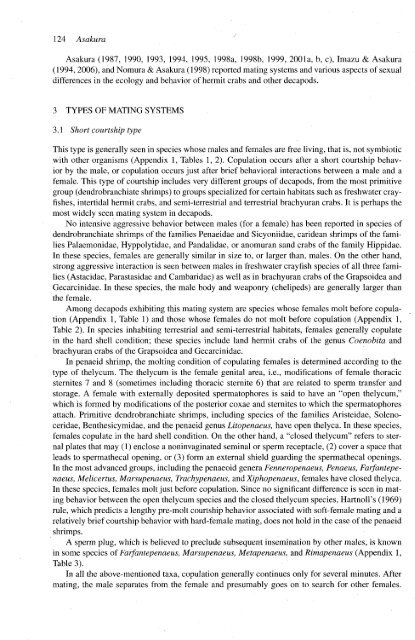Decapod Crustacean Phylogenetics - AToL Decapoda - Natural ...
Decapod Crustacean Phylogenetics - AToL Decapoda - Natural ...
Decapod Crustacean Phylogenetics - AToL Decapoda - Natural ...
Create successful ePaper yourself
Turn your PDF publications into a flip-book with our unique Google optimized e-Paper software.
124 Asakura<br />
Asakura (1987, 1990, 1993, 1994, 1995, 1998a, 1998b, 1999, 2001a, b, c), Imazu & Asakura<br />
(1994, 2006), and Nomura & Asakura (1998) reported mating systems and various aspects of sexual<br />
differences in the ecology and behavior of hermit crabs and other decapods.<br />
3 TYPES OF MATING SYSTEMS<br />
3.1 Short courtship type<br />
This type is generally seen in species whose males and females are free living, that is, not symbiotic<br />
with other organisms (Appendix 1, Tables 1, 2). Copulation occurs after a short courtship behavior<br />
by the male, or copulation occurs just after brief behavioral interactions between a male and a<br />
female. This type of courtship includes very different groups of decapods, from the most primitive<br />
group (dendrobranchiate shrimps) to groups specialized for certain habitats such as freshwater crayfishes,<br />
intertidal hermit crabs, and semi-terrestrial and terrestrial brachyuran crabs. It is perhaps the<br />
most widely seen mating system in decapods.<br />
No intensive aggressive behavior between males (for a female) has been reported in species of<br />
dendrobranchiate shrimps of the families Penaeidae and Sicyoniidae, caridean shrimps of the families<br />
Palaemonidae, Hyppolytidae, and Pandalidae, or anomuran sand crabs of the family Hippidae.<br />
In these species, females are generally similar in size to, or larger than, males. On the other hand,<br />
strong aggressive interaction is seen between males in freshwater crayfish species of all three families<br />
(Astacidae, Parastasidae and Cambaridae) as well as in brachyuran crabs of the Grapsoidea and<br />
Gecarcinidae. In these species, the male body and weaponry (chelipeds) are generally larger than<br />
the female.<br />
Among decapods exhibiting this mating system are species whose females molt before copulation<br />
(Appendix 1, Table 1) and those whose females do not molt before copulation (Appendix 1,<br />
Table 2). In species inhabiting terrestrial and semi-terrestrial habitats, females generally copulate<br />
in the hard shell condition; these species include land hermit crabs of the genus Coenobita and<br />
brachyuran crabs of the Grapsoidea and Gecarcinidae.<br />
In penaeid shrimp, the molting condition of copulating females is determined according to the<br />
type of thelycum. The thelycum is the female genital area, i.e., modifications of female thoracic<br />
sternites 7 and 8 (sometimes including thoracic sternite 6) that are related to sperm transfer and<br />
storage. A female with externally deposited spermatophores is said to have an "open thelycum,"<br />
which is formed by modifications of the posterior coxae and sternites to which the spermatophores<br />
attach. Primitive dendrobranchiate shrimps, including species of the families Aristeidae, Solenoceridae,<br />
Benthesicymidae, and the penaeid genus Litopenaeus, have open thelyca. In these species,<br />
females copulate in the hard shell condition. On the other hand, a "closed thelycum" refers to sternal<br />
plates that may (1) enclose a noninvaginated seminal or sperm receptacle, (2) cover a space that<br />
leads to spermathecal opening, or (3) form an external shield guarding the spermathecal openings.<br />
In the most advanced groups, including the penaeoid genera Fenneropenaeus, Penaeus, Farfantepenaeus,<br />
Melicertus, Marsupenaeus, Trachypenaeus, and Xiphopenaeus, females have closed thelyca.<br />
In these species, females molt just before copulation. Since no significant difference is seen in mating<br />
behavior between the open thelycum species and the closed thelycum species, Hartnoll's (1969)<br />
rule, which predicts a lengthy pre-molt courtship behavior associated with soft-female mating and a<br />
relatively brief courtship behavior with hard-female mating, does not hold in the case of the penaeid<br />
shrimps.<br />
A sperm plug, which is believed to preclude subsequent insemination by other males, is known<br />
in some species of Farfantepenaeus, Marsupenaeus, Metapenaeus, and Rimapenaeus (Appendix 1,<br />
Table 3).<br />
In all the above-mentioned taxa, copulation generally continues only for several minutes. After<br />
mating, the male separates from the female and presumably goes on to search for other females.

















